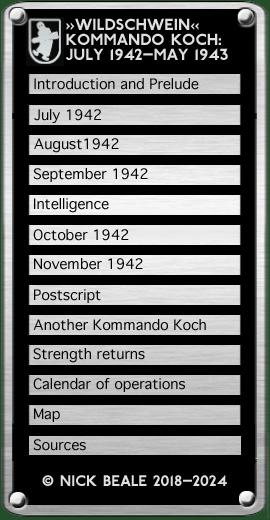|
On the 1st, one Heinkel was on submarine search ahead of the Zara convoy (presumably with radar) and one was giving jamming cover. No Allied transmissions were detected but Zara was torpedoed by British aircraft off Tobruk and had sunk by the next evening. With Zerstörer aircraft unavailable for daylight escort, pairs of cannon-armed Ju 88s had been proposed as a substitute and such machines were also expected to be useful after dark: Night 2nd–3rd Portofino to be continuously escorted by a cannon Ju 88 of Fliegerkorps X … to interrupt air attacks and to shoot down flares. (ULTRA QT 5022) On this occasion, it was LG 1 which supplied the Ju 88s and both had landed by 0645 hours. New jamming tactics were planned that night, with two aircraft operating as a feint over the Mediterranean, south west of Crete. It is possible that this stemmed from a suspicion that jamming transmissions told the Allies that here was something the Axis was anxious to hide. According to a later report, one He 111 was jamming from 1930–0500 hours but whether this was instead of or as well as the proposed feint is unclear. On the afternoon of 3 November, two Heinkels with search radar transferred to Trapani, Sicily. The Portofino convoy was protected by two He 111 jammers from 1815–2245, two Ju 88 of LG 1 from 2000 (these landed at Berca) and a Do 217 of the Nachtjagdkommando which was aloft from 2130–0330 hours. The escorting destroyer Hermes (ZG3) reported how the convoy had been: … attacked by several waves of aircraft from 0015 until 0330 [GMT+1]. Excellent combined torpedo attack on tanker Portofino beaten off with nothing to spare. The dropping of smoke-buoys for the bombers to bite on worked well. A novelty was the use of green flares, probably to indicate course. This doesn’t make it entirely clear whether the “smoke-buoys for the bombers to bite on” were a German feint (see above) or an RAF target-location aid. In any event, the convoy made safely it into Benghazi at 1213 on the 4th, only for the tanker to be destroyed in an air raid two days later. Owing to differences in equipment R/T, communication between all types of aircraft and [Luftwaffe] Signals Trupp of convoy not possible. Therefore aircraft control officers with Signals Trupp … to have FuG 10 with R/T attachment, so as to pass by W/T to high escort [a] warning of approaching low-level air attacks thus enabling fighters and Zerstörer to be directed on enemy in time. (ULTRA QT 5417)
Two Wildschwein Heinkel sorties took place “in [the] specified area” on the night of 4/5 November, one of them by GJ+JH On the following night there was not only a single jamming sortie but also another feint in the form of flare-dropping over the sea around 300 km NNW of Benghazi. Heinkel The Wellingtons of No. 221 Sqn. continued to suffer from jamming: on the night of the 2nd/3rd, 180 km north of Tobruk, this was “severe”; the following night, north of Benghazi, it was “very bad” while NW of Crete there was “S.I. interference”. Interference and jamming continued were around Crete (still firmly in German hands) on the 7/8th and 8/9th and also NW of Benghazi and over the Central Mediterranean on the 11/12th. Am quite confident that enemy will not use frequency modulated jamming for fear of jamming his own ASV aircraft but will continue single frequency jamming. AHQ Malta, 6 November 1942 Meanwhile, S/L Scott Farnie was following the retreating Germans across Africa in the hope of capturing electronic equipment, prompted by intelligence relayed from London: 9 November, Cadell to Scott Farnie: Would appreciate early reports on enemy decimetre link apparatus which may have fallen into our hands. Decimetre installations known to exist at El Daba, Tobruk, Sidi Barrani, Mersa Matruh and probably at intermediate points. 10 November, Cadell to Scott Farnie: WIM 9 dismantled and stored Mersa Matruh, 1st November 1942. It is known that we have captured wireless store here. Can the contents of store be searched for RDF, decimetre link, monitoring and jamming gear? 12 November, Scott Farnie to Cadell: Am going to Desert today for four or five days in hope of finding something. 17 November, Scott Farnie to Cadell: Have just returned from four days in desert after unsuccessful pursuit of Wotan’s wife [i.e. Freya] and Würzburg … No trace of any apparatus … Little doubt that apparatus is removed on first priority as is case of our own … hoped that might have found something shot up but although road from Alamein to Sollum is scene of complete carnage was not able to spot anything … W.I.M. station at Mersa Matruh was not found but in any case all W.T. stores have been removed.
continued on next page …
|
|||||

TIMELINE |
|
5 November |
Eighth Army breakthrough at El Alamein. |
8 November |
Operation Torch, Allied landings in French North Africa. |
9 November |
Sidi Barrani taken by Eighth Army. |
13 November |
Eighth Army takes Tobruk. |
15 November |
Eighth Army captures Derna. |

